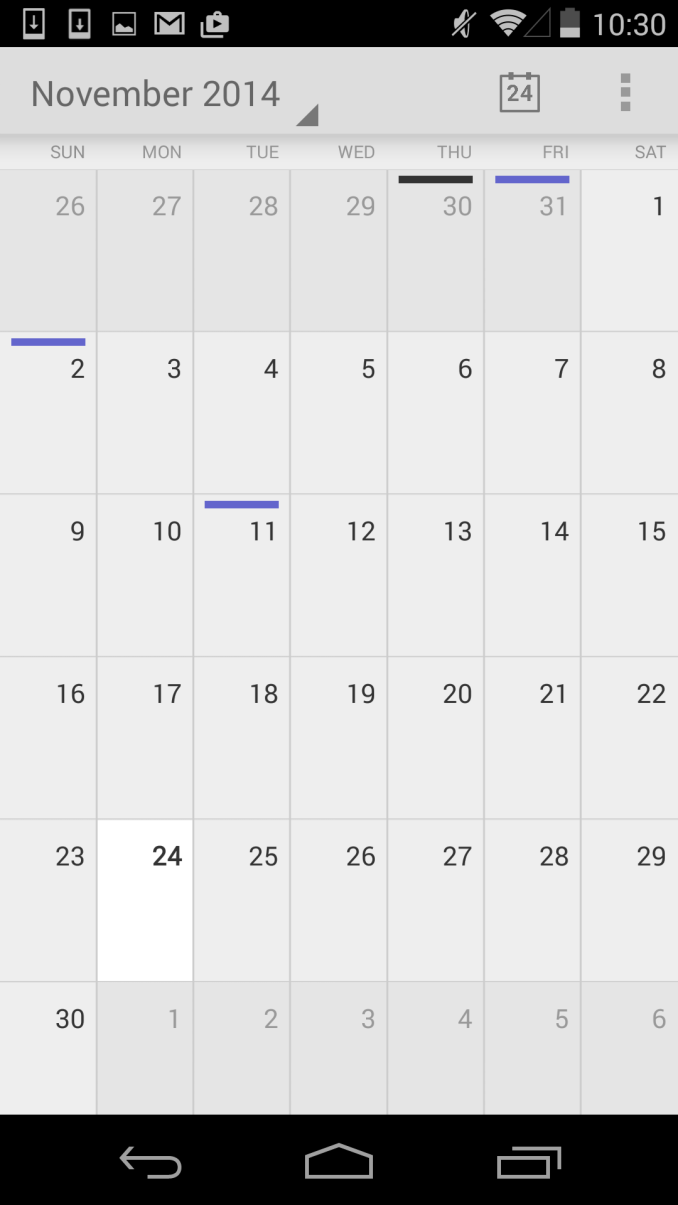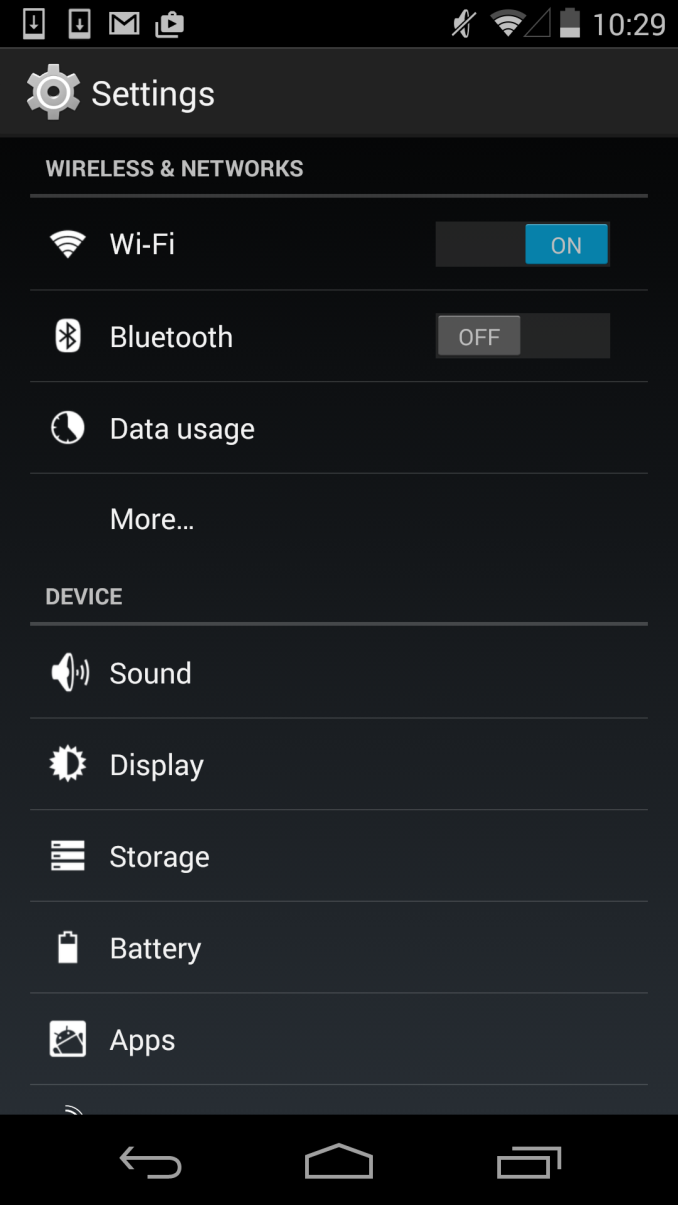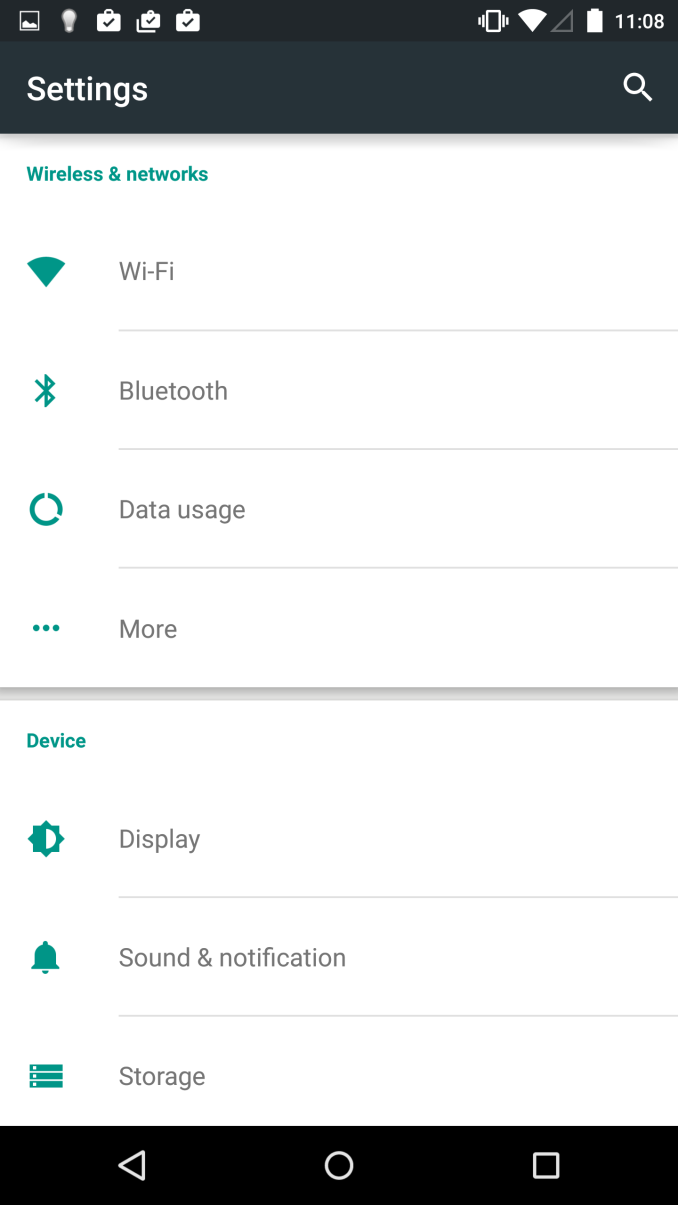The Android 5.0 Lollipop Review
by Brandon Chester on December 1, 2014 10:00 AM EST- Posted in
- Smartphones
- Android
- Tablets
- Android 5.0
Material Design
A good place to begin before discussing the operating system itself is to explain what exactly "Material Design" is. The term comes up a lot throughout the course of the review, which makes sense given how the biggest changes that users will see when moving from KitKat to Lollipop will be because of Material Design. Material Design is a set of design principles, and contained within them is something of a mission statement about Google's approach to services across multiple platforms. Material Design is definitely not Google's first big change to the Android interface, but this time I'm actually very confident that it will be the last we see for a very long time. I'm very impressed by the work Google has done to create an interface that looks and feels modern, simple, and beautiful. Before getting into what Material Design looks and acts like, I'd like to address and give my thoughts about Google's previous style of interface design which was called Holo.
To me, Holo always seemed like a transitional type of interface. Google had just brought on Matías Duarte, but as someone whose first smartphone was a Palm Pre, I didn't feel his influence anywhere at all. I think that Holo was a definite improvement over the previous Android interface, but that isn't really saying much. In my opinion, it still didn't feel coherent or look visually appealing. For example, if you showed me the two screens above without the status bar and navigation buttons, I would be hard pressed to tell you that they're from the same operating system. They don't share a single common interface element. The lack of color and use of grey was also questionable. While some users protest the heavy use of white in many modern interfaces, to me the grey that was commonly used in Holo Light applications was analogous to a dirty white cloth. The lacking color also made applications feel rather dull and lifeless, and I almost wondered if it was an effort to try and mask the fact that phones were shipping with either under-saturated or over-saturated displays by just having almost no color at all.
With my disappointment in Google's new interface, I was worried that it would just be something I would have to deal with for many years. Fortunately, less than one year after Android Ice Cream Sandwich was released, we were given a glimpse of the beginnings of a new type of design that was distinctly not Holo. It was in a feature called Google Now which launched with Android 4.1, and that many people now use everyday. This application used bright white cards to display relevant information, and had a much heavier use of color than any other applications that shipped along with Android. While at the time this could have been dismissed as the most obvious way to make an application that is constantly displaying and updating information for the user, in hindsight it was clearly the beginning of a new type of design being practiced at Google. It was still immature, lacking the animations, drop shadows, and dynamic nature of Material Design, but it began the dissolution of the Holo interface that had just been introduced.
Finally with the end of Holo, comes the beginning of Material. When Google gave a sneak peek of the new interface for Lollipop at Google IO I was very excited by what I saw seeing. The basic idea of the cards in Google Now had been applied to the entire operating system, and expanded upon in ways that I hadn't expected but have been pleasantly surprised by. As you can see above, both applications display the sections of the interface on white cards that float above the background and cast slight shadows. There's also a much greater use of color, and a better use of screen real estate by dividing the application into multiple sections which can be seen in the new Calendar application. The Settings application is actually a bad example in this regard, as the increased spacing means the main page fits less on screen than before, but this is an exception and I included it primarily to show the contrast between new and old.
Material Design is based upon the ideas of paper, lighting, shadows, depth, and color. While this sounds a lot like the skeuomorphic interface of previous versions of iOS, Material Design doesn't limit itself based on the actual limits of physical items like paper, and it doesn't go to the point where applications are merely digital recreations of real world objects. There's also a heavy use of animations. Everything you touch seems to respond with an elegant animation, and the different cards in the interface can expand, contract, and stack atop one another to create an extremely dynamic feel. It is truly hard to explain, and it's really something that needs to be used to be fully understood.
The last thing to say about Material Design is how it represents more than just a way to design applications. Like I said earlier, within Material Design is a mission statement about Google's approach to services across multiple platforms. Although I've discussed it within the context of the Android platform, Material Design is going to be what you see in Google's applications across every platform. From web apps, to Android, to Chrome, to iOS applications, you will see a consistent style of design that adapts to different display sizes, use models, and methods of input. Overall this is a great step forward in making Google's services consistent across all devices, but I think in the context of iOS applications Google may be going a bit too far by ignoring the design guidelines of that platform in favor of their own.














126 Comments
View All Comments
OreoCookie - Monday, December 1, 2014 - link
But that's as misguided a statement as »Microsoft didn't invent squares« or »Apple didn't invent rounded rectangles«: Microsoft deserves kudos for being the first to pick up on this trend on a large scale. And if you claim »but they didn't invent it« what you really want to say is that you don't want to give them credit for it.HisDivineOrder - Tuesday, December 2, 2014 - link
I find that most people care less for who does something first and more for who does something best.tralalalalalala40 - Monday, December 1, 2014 - link
Design is never new. People copy each other in this area all the time. Look to the world of fashion how crazy fast people copy.HackerForHire - Monday, December 1, 2014 - link
Maybe because you're incorrect and couldn't be more wrong? To associate a connection between material design and that hideous metro interface is just ludicrous. I've used both interfaces and thankfully I've abandoned that ugly metro interface with its superfluous animations that did nothing but hide the performance problems of the OS. Additionally, it seems the only people complaining about the similarities are butt hurt windows phone fanboys that are upset their OS of choice in tanking so hard.theduckofdeath - Monday, December 1, 2014 - link
Microsoft throwing toys out of the pram because they messed up on mobile (again)...Windows Phone will keep failing as long as Microsoft keeps trying to sell us another closed and locked down ecosystem.
haukionkannel - Tuesday, December 2, 2014 - link
Well... Apple is selling closed and locked ecosystem and is doing better than Android...The WP is just fine mobile os! It is something between iOs and android when compared how locked down it is. It has been very snappy and light (a good thing !) it has been new (bad thing ?)
I have used all those three and all of them have their advantages and disadvantages. It is really good that we have three ecosystem. It keeps competition high enough!
kyuu - Thursday, December 4, 2014 - link
Right. Closed and locked down are the ultimate sins for a mobile operating system and doom it to failure. Just ask Apple.Hyper72 - Monday, December 1, 2014 - link
I'm guessing most people are not in denial, they just don't care whether ideas have been copied, independently developed or somewhere in-between or perhaps trends followed as another commented. Taking inspiration is how the industry have moved for decades and generally it benefits the user.Narg - Tuesday, December 2, 2014 - link
Obviously they don't care. Don't you see how quiet and peaceful they are about the changes.... Oh, wait.tuxRoller - Tuesday, December 2, 2014 - link
Material isn't flat. It uses shading to indicate a z dimension (or layers).